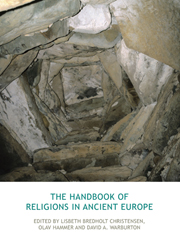Book contents
- Frontmatter
- Contents
- A note on Greek and Latin sources
- Abbreviations and short titles
- 1 Introduction
- PART I PREHISTORIC RELIGIONS
- 2 Studying prehistoric religions
- 3 Prehistoric material and religion: a personal odyssey
- 4 Francesco d'Errico and the origins of religion
- 5 On Palaeolithic religion
- 6 Ian Hodder and the Neolithic
- 7 Neolithic cult images? The testimony of figurines for Neolithic religion
- 8 Religious practices in northern Europe 4000–2000 BCE
- 9 Mythological aspects of Nordic Bronze Age religion
- 10 Religion and society in the Bronze Age
- 11 The religions of prehistoric Europe and the study of prehistoric religion
- PART II ANCIENT EUROPE IN THE HISTORICAL PERIOD
- Timeline of key dates
- Contributors
- References
- Index
8 - Religious practices in northern Europe 4000–2000 BCE
from PART I - PREHISTORIC RELIGIONS
- Frontmatter
- Contents
- A note on Greek and Latin sources
- Abbreviations and short titles
- 1 Introduction
- PART I PREHISTORIC RELIGIONS
- 2 Studying prehistoric religions
- 3 Prehistoric material and religion: a personal odyssey
- 4 Francesco d'Errico and the origins of religion
- 5 On Palaeolithic religion
- 6 Ian Hodder and the Neolithic
- 7 Neolithic cult images? The testimony of figurines for Neolithic religion
- 8 Religious practices in northern Europe 4000–2000 BCE
- 9 Mythological aspects of Nordic Bronze Age religion
- 10 Religion and society in the Bronze Age
- 11 The religions of prehistoric Europe and the study of prehistoric religion
- PART II ANCIENT EUROPE IN THE HISTORICAL PERIOD
- Timeline of key dates
- Contributors
- References
- Index
Summary
For archaeology, access to prehistoric religion must lie in religious practices, notably practices that leave discernible traces. Typically these may be burials, sacrificial sites, particular artifacts, idols and other depictions. It is, however, important to be aware that religious practices are not limited to such finds. Religious practices are more likely than not to have also been entangled in more profane matters such as the organization of house interiors or activities in and around houses (e.g. Yates 1989), artifact production (e.g. McGhee 1977), diet (e.g. through food taboos), and so on. Similarly, perceptions of the landscape and its inhabitants are often important (A. Schanche 2000; Sjögren 2003). Studies exploring such aspects of Neolithic religion in northern Europe are, however, scarce. In the following, religion is understood as practices with cosmological associations, whether explicitly ritual or not.
The presentation of religions practised in northern Europe during the Neolithic will be confined geographically to Fennoscandia (the Scandinavian countries, Finland, and adjacent parts of Russia), and chronologically to the period roughly 4000–2000 BCE. In addition to the religious practices of the agricultural societies of southern Scandinavia, the very different religion among contemporary hunter-gatherers of northern Fennoscandia will be discussed. The intention is to trace a number of fundamental practices and elements that would appear to have been at the core of the cosmological understanding and consequently less prone to regional and chronological variation (for a similar search for repeated and reproduced practices see Nilsson Stutz 2003, 2010).
- Type
- Chapter
- Information
- The Handbook of Religions in Ancient Europe , pp. 63 - 69Publisher: Acumen PublishingPrint publication year: 2013



